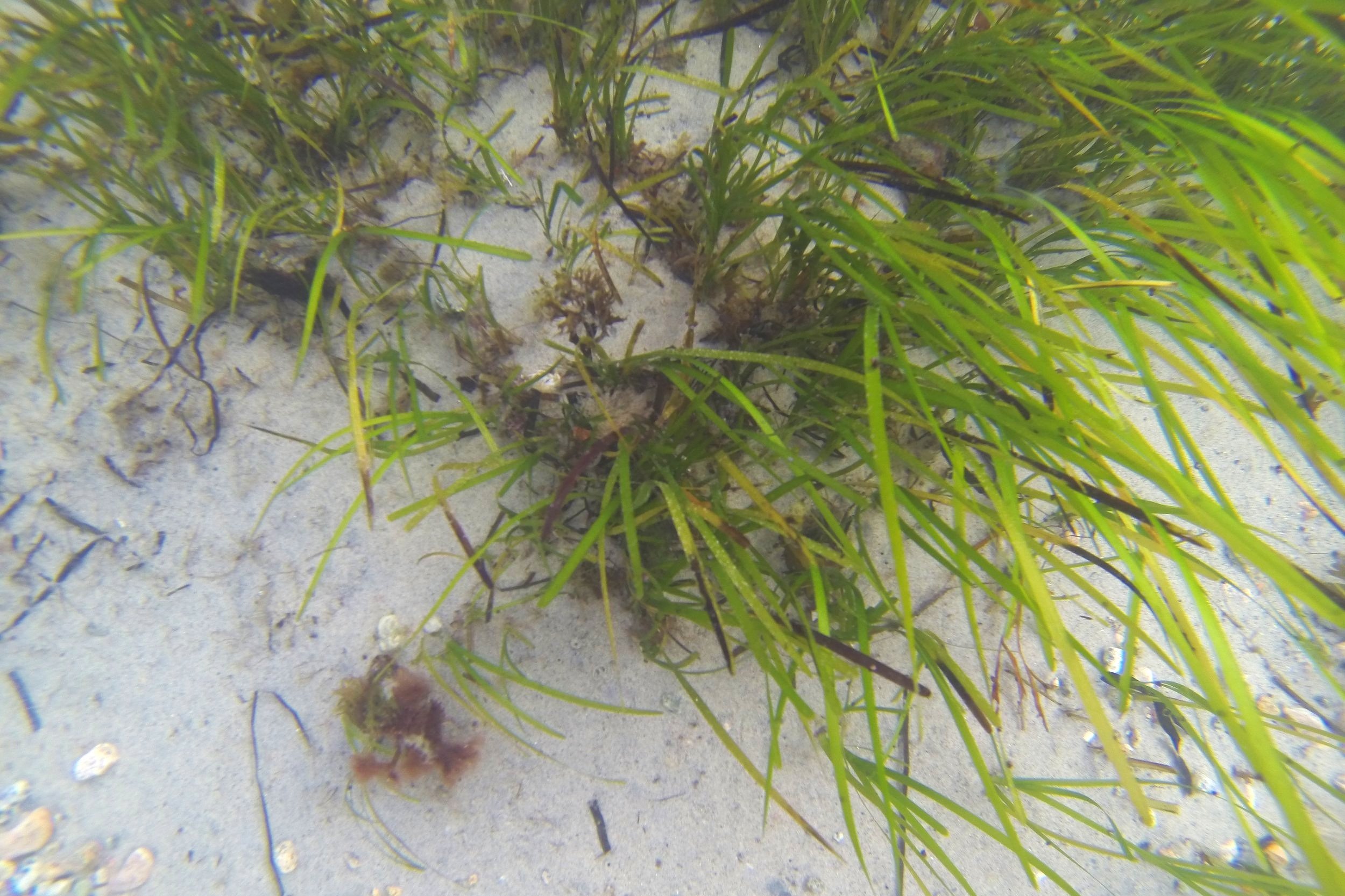What’s the Harm? - Propeller Scars
Boating is one of the many ways Fishers Island residents and visitors enjoy their leisure time, but what happens when recreation leads to the destruction of marine habitat? Most boaters do not know that their actions can directly affect eelgrass habitats, and even fewer know why they should look out for these underwater meadows. Today, we are looking at what can happen when shallow waters, motorized boats, and eelgrass meet.
Repeated scarring leads to sparse meadows that are hampered in their ability to provide valuable ecosystem services like carbon and nitrogen sequestration, erosion control, and marine habitat. PC: Emily Bodell
Eelgrass lives in shallow, sheltered coastal areas – this habitat preference also tends to describe areas boaters like to be in. For eelgrass conservation efforts to be successful, we must find a way for eelgrass and boaters to coexist. The first step along this path is for boaters to be aware of their potential for harming these essential ecosystems.
Why should we care about eelgrass beds?
Eelgrass provides four primary services that Long Island Sound residents enjoy:
1. Marine Habitat – eelgrass provides a home for spawning and juveniles that supports stable recreational and commercial fisheries. Its complex habitat also provides superb foraging grounds for grazers that eat eelgrass blades or the epiphytes and epifauna that live on the blades. Finally, eelgrass provides shelter from predatory fish and seabirds.
2. Erosion Control – Dense, healthy meadows accumulate sediments and secure them in place, ensuring that tides, currents, and waves do not pull them away from the coastline. These eelgrass meadows also slow the speed and decrease the power of the tides, currents, and waves, which minimizes their impact on the coastline.
3. Pristine Water – Just like the sediments are pulled out of the water by the dense meadows, so are pollutants like phosphorous and nitrogen. With eelgrass securing these particles in the sediments, these excess nutrients are unlikely to fuel algal blooms that will cloud the water, create low oxygen zones, and potentially create harmful algal blooms and fish kills.
4. Blue Carbon – One of the most significant global impacts created by eelgrass is its power to pull carbon out of the atmosphere and sequester it in the sediments. Coastal ecosystems like eelgrass are responsible for half of global blue carbon despite only taking up less than 2% of the world's ocean area.
So, how do propellers damage eelgrass beds?
In shallow waters, boat propellers can damage eelgrass beds in the following ways:
1. Cutting – Much like mowing a lawn, propellers can chop off the taller parts of the meadows. This decreases the meadow’s capacity to hold, shelter, and feed marine life [1]. Reduced leaf height will also negatively impact the meadow’s ability to minimize the impact of erosion and its sequestration capability. Luckily, eelgrass leaves grow quickly, so this damage is not long-term.
2. Scarring – This action is far more damaging than cutting. Fast-moving boats in shallow water can dig their propellers into the ocean sediments. In eelgrass beds, this will uproot large strips of eelgrass and dislodge the sediments and pollutants the eelgrass sequestered. The damage here can be severe. The marine habitat becomes fragmented, providing less shelter to the marine life that inhabits the area. The sediments in the water column are likely to be fine, silty sediments that create turbid, unclean water for a prolonged period. This long-term damage is unlikely to be repaired for several years as the remaining eelgrass attempts to regrow over the damaged portion [2]. As the regrowing process occurs, it is vulnerable to the effects of erosion that may create conditions that further impair the meadow [3].
What can boaters do to prevent this?
Preventing eelgrass damage is simple once you know when and how! The shallow coastal areas of Fishers Island are full of eelgrass, so you will have plenty of opportunities to practice seagrass-safe actions.
Preventing propeller scar damage is simple, starting with knowing where to look. Fishers Island’s coastline is filled with eelgrass, which makes it a priority stewardship area of Long Island Sound. Please look out for it when boating in water 10 ft deep or less. Eelgrass can grow in waters up to 30 feet deep, though, so keep that in mind when thinking of dropping an anchor! Check out our eelgrass survey map to explore the most recent data on eelgrass locations.
Trim up your motor and travel slowly in shallow water over an eelgrass bed. This will minimize the cutting damage to the eelgrass leaves and hopefully eliminate the chance of scarring the bed. As a bonus, this extra caution will help keep your propellor clean and undamaged.
Finally, if you find that your boat has run aground, avoid the temptation to use your motor to get yourself out of the situation. Using your motor could damage your property, uproot eelgrass, and kick sediments into the water. Instead, try to push your boat into deeper water manually!
In Summary…
Boat propellers damage the root systems of eelgrass and make it challenging, if not impossible, to regrow. This is troubling because damaged eelgrass means it can no longer provide critical ecosystem services such as marine habitat, erosion control, pristine waters, and blue carbon. We must take steps to reduce the impact of propellers on these ecosystems to ensure the health and survival of the many species (including humans) that rely on them!



